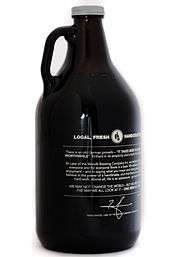Growler (jug)
A growler (/ˈɡraʊlər/) is a glass, ceramic, or stainless steel bottle (or jug) used to transport draft beer in the United States, Canada,[1] Australia, Brazil and other countries. They are commonly sold at breweries and brewpubs as a means to sell take-out craft beer. Rarely, beers are bottled in growlers for retail sale. The significant growth of craft breweries and the growing popularity of home brewing has also led to an emerging market for the sale of collectible growlers. Some U.S. grocery stores, convenience stores, bars and restaurants have growler filling stations.[2][3][4]

Crowlers ("Canned Growler") are a more modern and similar concept: a fillable and machine-sealable beer can.[5] The selected beer is poured into the can body and then a pop-top is sealed over it at a canning station. It isn't reusable like a growler bottle, but is easier to transport. The major limitation is that they can only be about a quart (32 oz. [946-ml] or 40 imp oz [1136-ml]) or liter (33.8 oz or 35.2 imp oz) in size.
Overview
Composition
Growlers are generally made of glass and have either a screw-on cap or a hinged porcelain gasket cap, which can maintain freshness for a week or more. A properly sealed growler will hold carbonation indefinitely and store beer like any other sanitized bottle. Some growler caps are equipped with valves to allow replacement of carbon dioxide lost while racking. The modern glass growler was first introduced by Charlie and Ernie Otto of Otto Brothers' Brewing Company in Wilson, Wyoming, in 1989.[6]
The two most popular colors for growlers are amber (a brownish hue) or clear (often called "flint"). Clear growlers are often 25% to 35% more per unit than their amber counterparts. Glass handles are the most common type of handle for growlers, although metal handles, with more ornate designs, can also be found. Some growlers do not have handles; this is especially common with growlers smaller than 64 U.S. fl oz that have Grolsch-style flip-tops.[7]
Sizes
While 64 U.S. fl oz (1,892.7 ml; 66.6 imp fl oz) is the most popular growler size, growlers are commonly found in 32 U.S. fl oz (1 US Quart, sometimes known as a "howler", which may be short for "half growler"), 128 U.S. fl oz (1 US Gallon), 1-liter (33.8 U.S. fl oz; 35.2 imp fl oz), and 2-liter sizes as well.
History
The term likely dates from the late 19th century when fresh beer was carried from the local pub to one's home by means of a small galvanized pail. It is claimed the sound that the carbon dioxide made when it escaped from the lid as the beer sloshed around sounded like a growl.[10]
See also
References
- "Craft beer jug refills now allowed at public, private liquor stores". CBC News. March 1, 2016. Retrieved March 2, 2016.
- WDBJ7 (February 18, 2016). "Roanoke Valley grocery store to open beer and wine growler bar". wdbj7.com. Archived from the original on March 7, 2016. Retrieved March 2, 2016.
- Smith, Ryan (February 16, 2016). "Growler service station to hit convenience stores". KCCI. Retrieved March 2, 2016.
- Frisinger, Cathy (February 9, 2016). "Restaurant review: Pouring Glory Growler Fill Station and Grill". star-telegram. Retrieved March 2, 2016.
- https://www.bonappetit.com/drinks/beer/article/what-is-a-crowler-beer
- "History of Growlers". Grand Teton Brewing Company. Retrieved 2010-10-22.
- "Complete Guide To Buying Growlers". Kinnek.com. Retrieved 2011-01-05.
- Dzen, Gary (June 3, 2015). "State's growler law up for debate". BostonGlobe.com. Retrieved March 2, 2016.
- Mobley, Esther (February 17, 2016). "Fort Point Beer plants flag at Ferry Building". SFGate. Retrieved March 2, 2016.
- "The Growler: Beer-to-Go!". Beeradvocate.com. Archived from the original on 2013-01-20. Retrieved 2008-11-12.
Further reading
| Wikimedia Commons has media related to Growlers. |
- "Everybody Wins When You Buy a Growler". KCET. January 17, 2013. Retrieved March 2, 2016.
- Soroka, W, "Fundamentals of Packaging Technology", IoPP, 2002, ISBN 1-930268-25-4
.jpg)